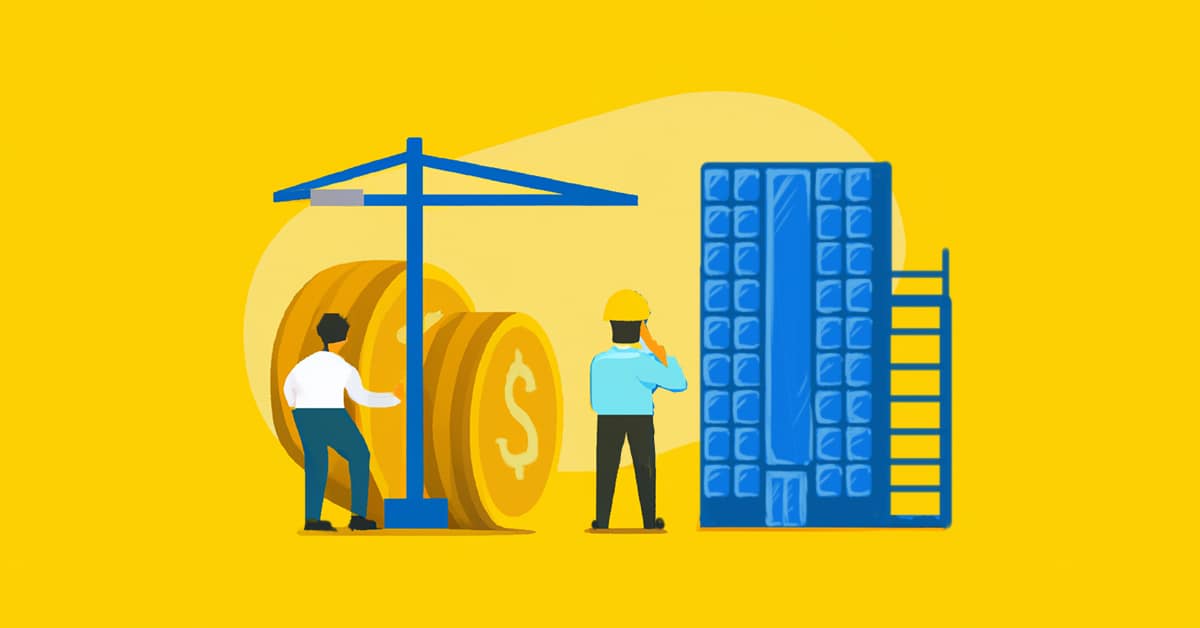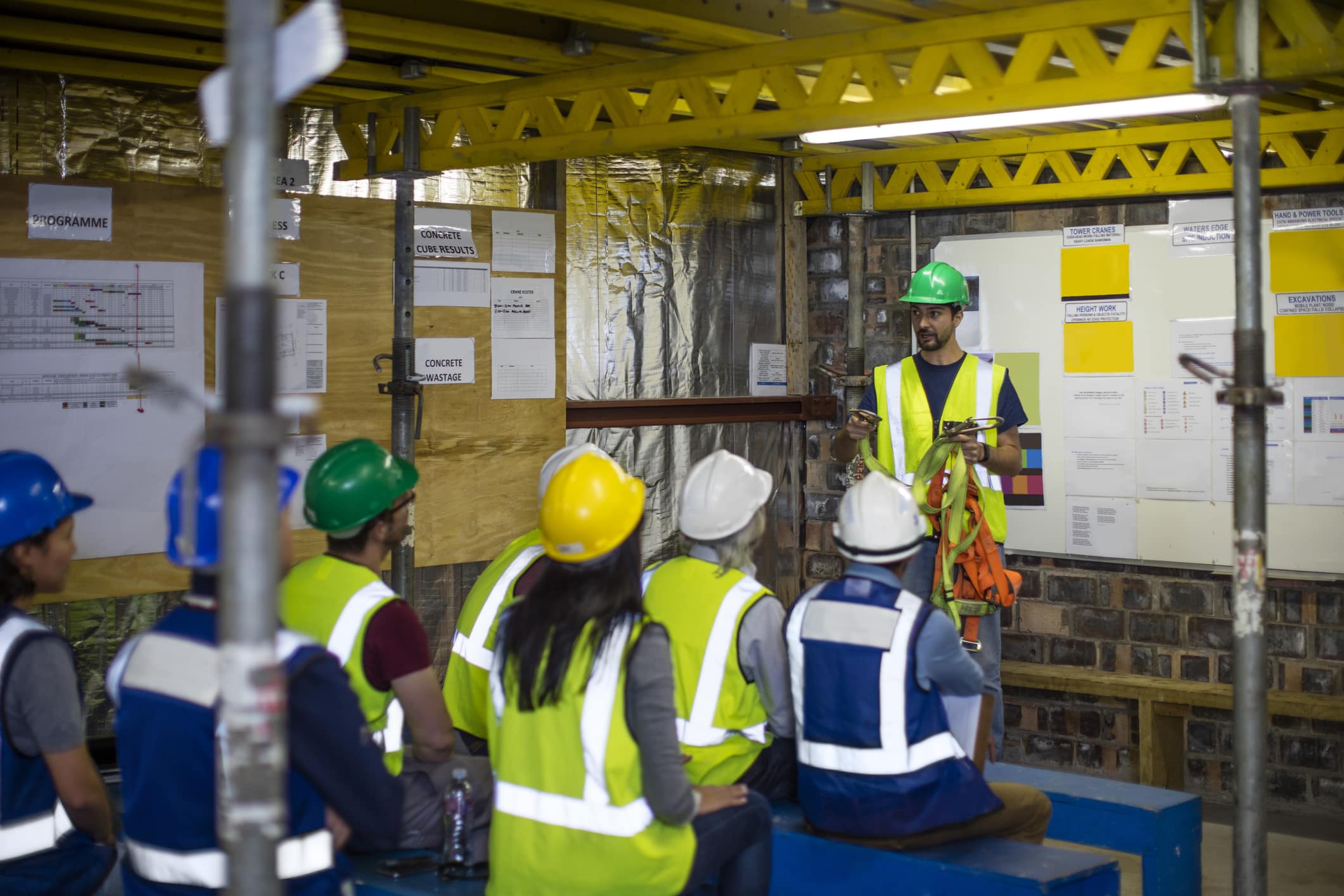Accurate Labor Tracking Is So Much Easier With Workyard
Construction takeoffs help contractors assess total project costs using a comprehensive list of materials. Sometimes referred to as a material takeoff, a construction takeoff is an essential forecasting resource for all construction projects.
Contractors risk overcharging and undercharging when submitting bids without first performing takeoffs. In this article, we take a look at how to get a project off the ground with a takeoff.
What Is a Construction Take Off?
A take off is the process of interpreting blueprints to figure out the quantities of all materials necessary for the completion of a project. A take off consists of each item’s name, estimated quantity needed, and cost. The concept of a construction takeoff can make the task of completing one seem deceptively simple.
Takeoff complexity often matches project complexity. However, the time requirement needed to compile a takeoff for a project of any size shouldn’t be shrugged off. Takeoffs need to be polished because they are often presented as a final report to stakeholders.
There’s no “rough draft” element to construction takeoffs. While they are created in the initial stages of a construction project, takeoffs must be accurate and polished.
Consider the heavy stakes of an inaccurate takeoff.
If a takeoff calls for the wrong raw materials to be ordered, a project may experience time-consuming, costly delays that drastically slow things down. Contractors must also be careful about “guesstimates” on takeoffs. Ordering too many materials can result in losses.
While a takeoff is primarily a costing resource, it is also an important communication tool. It’s very common for a takeoff to be shared with clients/developers, designers, architects, engineers, and subcontractors.
How Take Offs Are Used in the Construction Industry
Take offs are used both internally and outwardly by contractors. The primary purpose of a takeoff is helping a contractor to determine how much of each material to purchase. This information can be used to create an estimate for a job, submit a bid to a client, or get an accurate figure for an internal purchasing department.
Let’s look at how creating a takeoff might play out in a variety of scenarios.
Submitting a Bid Using a Take Off
A flawless take off allows a contractor to incorporate accurate material quantities into a bid. Without a takeoff, a contractor faces two devastating scenarios. The first is losing out on a job due to overbidding. The second is winning a job through underbidding.
In one scenario, a contract makes nothing. In the other, the contractor stands to lose money on a job.
Creating Estimates With a Take Off
When creating both internal and client-facing estimates, knowing how much of any material is needed is essential. Performing a takeoff provides an accurate, semi-certified answer that allows you to “price in” labor, tax, waste, and other costs to create a complete estimate.
Determining Material Quantities With a Take Off
Takeoffs are still helpful when the pressure of submitting a figure to a client is off the table. Without a takeoff, you’re likely to either overbuy or underbuy materials. This can lead to everything from delays caused by shortages to lost profits caused by unusable materials.
In most cases, contractors and subcontractors are tasked with creating takeoffs. The burden typically falls on their shoulders simply because they are the ones bringing project expertise to the table. They are also the ones who are ultimately responsible for project costs. However, some contractors work with estimators on complex projects.
Construction Takeoffs vs Estimates
Is a construction takeoff the same thing as an estimate? No, the two aren’t interchangeable. However, a takeoff can be an essential part of the estimating process. What’s more, both are necessary for accurate costing.
While a takeoff has the singular focus of determining material amounts needed for a job, estimates have the multifunctional purpose of applying the costs of materials on a takeoff to create a project budget.
Let’s recap the difference between a construction takeoff and construction estimate to make sure the distinction is as clear as day. Unfortunately, people who aren’t familiar with construction costing will sometimes confuse contractors during negotiations by conflating the two.
A takeoff determines only the amount of all of the individual materials needed to complete a construction project. That’s the full extent of the information provided.
A construction estimate applies costs of materials within the takeoff list to the project budget.
What Do Takeoffs Typically Include?
Takeoffs should include all materials involved with every stage of a construction project. This includes both raw and manufactured elements. The most common items found on a construction takeoff include:
- Wood
- Steel
- Concrete
- Cables
- Lights
- Pipes
- Doors
- Windows
- Rebar
- Sand
- Tiles
- Flooring materials
- Light fixtures
- Secondary industrial supplies
It’s almost as important to know what not to include on a takeoff. Many people who are new to construction costing will throw any project-associated cost on the takeoff because they wrongly believe that it serves as a construction project estimate instead of a list of all the materials.
The first big category that doesn’t belong on a construction takeoff is labor. While labor is one of the biggest costs associated with a construction project, it is not to be included in a construction takeoff.
The list of other important and significant expenses that do not belong on an accurate takeoff includes office overhead costs, shipping and transportation costs, equipment rental costs, and storage fees.
The Importance of Accurate Construction Takeoffs
An inaccurate construction takeoff has disastrous implications. As touched upon earlier, an inaccurate takeoff can cause a contractor to order incorrect amounts of key construction materials.
A construction takeoff’s only value is its accuracy. That’s because only an accurate takeoff can translate to an accurate final cost estimate. Contractors can’t make important purchasing decisions without accuracy. They also can’t pass on accurate estimates to clients.
When a client is presented with an estimate completed using an inaccurate takeoff, they are making decisions based on inaccurate guarantees. The disappointment stemming from an inaccurate takeoff can manifest in a number of different ways for a client.
First, a client may be presented with an inaccurate price estimate that drastically increases as a project moves forward. For the contractor, this can result in hostility, unpaid bills, court actions, and a poor reputation within a community. Even clients who aren’t stuck holding the bag for costs that weren’t factored into an original estimate due to a poorly done takeoff still have plenty of frustrations in store.
The biggest problem stemming from an inaccurate takeoff on the client side is the “bottleneck” problem. When contractors fail to order enough materials, project delays are inevitable. Delays can be even more dramatic during a time when product shortages are considered normal. This leaves a client dealing with a secondary delay on top of what may have already been a long wait time while materials that were ordered on time came trickling in.
For the contractor, inaccurate takeoffs create headaches that can create legal and financial troubles. Contractors are generally responsible for any costs that weren’t disclosed during bidding. That means that an inaccurate takeoff could wipe out a project’s profitability.
Contractors also face penalties when project deadlines are missed. Aside from the negative consequences of disappointing a client, missed deadlines caused by poorly done takeoffs also create logistical headaches for contractors.
A contractor may have spent weeks carefully orchestrating collaborations between architectures, designers, engineers, plumbers, laborers, and subcontractors. A shortage of materials could require the contractor to push back dates that were already marked on the calendar. These become days when scheduled workers don’t get paid.
In addition to pushing back the date for a key part of the construction project, a single delay caused by missing materials can have a domino effect that requires a contractor to rebook dozens of appointments and “start dates” until preceding steps can be completed. This can dramatically push back the completion date for a project. As stated earlier, delays can open a contractor to liability and penalties. Of course, it’s simply bad business to constantly provide inaccurate dates.
Being caught in a trend of constant project delays due to improper material orders can also prevent a contractor from beginning new projects because resources are constantly tied up in ongoing projects. It’s simply not the way to run a profitable construction business.
The bottom line is that contractors capable of generating accurate takeoffs lower their financial risks. They’re also more likely to gain repeat clients.
Using Construction Takeoff Software
Software automates the construction takeoff process lets contractors quickly create accurate takeoffs.
Yes, it’s still common for contractors to use the old-school method of creating manual takeoffs. However, the industry is generally moving beyond this approach due to its potential for inaccuracies. Let’s cover what the old-school process of creating a manual takeoff looks like before diving into digital takeoffs.
When creating a manual takeoff, a contractor spends time studying a project’s blueprints to create an itemized material list based on project scope. Using prior experience, the contractor generally makes educated guesses regarding the quantities needed based on measurements found in the blueprints.
Takeoffs are often dreaded by contractors because they require a tedious, time-consuming process. Complex mathematical equations and calculations are needed to get numbers on paper. This is why most contractors are moving forward with digital takeoffs.
“Digital” takeoffs are takeoffs created using takeoff software. These programs empower contractors to prepare takeoff documents in minutes using just a few simple steps. Yes, that means that takeoffs are created in minutes instead of days. Here’s a rundown of the benefits of using takeoff software instead of manually creating takeoffs:
- Accuracy: Digital takeoffs tend to be far more accurate than manually created takeoffs. In fact, the higher accuracy rate is inherent in the software’s design. Using AI-generated calculations, takeoff software is able to pull material data directly from the blueprints. This takes the burden of having expert-level familiarity with takeoffs off of a contractor’s shoulders.
- Cost Savings: Newer contractors who feel intimidated by takeoffs may be able to perform their own takeoff generation without hiring a professional estimator if they can find the right software. Even experienced contractors who feel confident in their takeoff-building abilities may find that they simply prefer to use their time and talent in better ways.
- Faster Takeoff Creation: A quality, precise takeoff can be created in minutes using a software program. What’s more, the need for confirmation and auditing that goes along with making your own calculations gets eliminated.
- Fast Updates: Takeoff software makes takeoffs more dynamic. When adjustments need to be made after the initial takeoff draft has been created, material costs and quantities can be quickly updated in real time. The updated record becomes the record for anyone who needs to utilize the data for ordering, budgeting, or decision-making purposes. Contractors who integrate cost-estimating software with their digital takeoff methods can get takeoffs done without even exiting their preferred programs.
- Access: One of the understated benefits of using takeoff software is that it provides incredible access to takeoff documents from anywhere. When using cloud-based takeoff software, plans can be viewed, shared, and updated from anywhere using a mobile device. For contractors, that means access to important data from home, work, or construction sites. It also means easy sharing for all stakeholders.
- Organization: Digital takeoffs increase organization by removing the need to keep track of piles of paperwork. Digital files make it easy to glance at figures whenever they need to be references instead of digging through files to find an updated copy.
What does using construction takeoff software look like? The honest answer is that the process remains very similar to the manual process. Of course, these programs allow contractors to go through the same process with increased speed and accuracy.
All of the complex processes that make manual takeoffs so frustrating to create are automated with digital takeoffs. You’re simply recreating the manual takeoff process in a way that’s better than what any human could do. Here’s what the process might look like:
- The software program scans the project blueprint.
- Next, the software reads the blueprint.
- The software’s intelligence builds a list of required materials to create a takeoff.
- The contractor/estimator then has a chance to make adjustments based on project-specific knowledge. Many contractors choose to account for waste when creating takeoffs.
While digital takeoffs eliminate the need for manual calculations, they still allow for the contractor or estimator to make important adjustments. Once adjustments are made, they are then dynamically updated to ensure that the updates are reflected on the digital file within the system.
Using Construction Takeoff Services
Some contractors prefer to hire professional estimators to handle construction takeoff services. A professional construction takeoff service can be an asset when compiling takeoff data for a large, highly specific project. Hiring a licensed team of takeoff professionals may help you to win high-stakes bids that require familiarity with a certain type of construction.
Most contractors find that the cost to hire a professional service isn’t necessarily worth it unless they are working on specialty projects that don’t fit the mold of mainstream digital takeoffs. It’s also important to realize that takeoff services that bill contractors for their services are typically using a hybrid approach that fuses digital takeoff software with human expertise.
In some cases, professional estimators are actually just using the same software that’s available directly to contractors.
Contractors should never “take a shot in the dark” when it comes to figuring out costs for any aspect of a project. An accurate take off is essential for running a competitive, profitable contracting business with staying power.
Accurately Estimating Labor Costs
It’s important to never lose sight of the fact that labor is often the costliest aspect of any construction project.
That’s why no conversation about using takeoff software to create better estimates should be had without also discussing how to integrate construction time tracking software into the bigger picture for better, smarter, and more accurate estimates that land bids.
Busy contractors don’t have to stress about unwittingly going under budget or over budget on any job. Regarded as the most accurate construction time tracking software for contractors, Workyard makes tracking time on every job using relevant cost codes easy.
Contractors who use Workyard easily manage construction labor costs by managing and measuring project progress in the Workyard app. Workyard makes tracking time on every job easy.
Contractors who use Workyard easily manage construction labor costs by managing and measuring project progress in the Workyard app. Workyard makes tracking time on every job easy.
Did you find this post helpful? Please rate it!




 (No Ratings Yet)
(No Ratings Yet)


